3-Day Road Trip along the Coast of Normandy
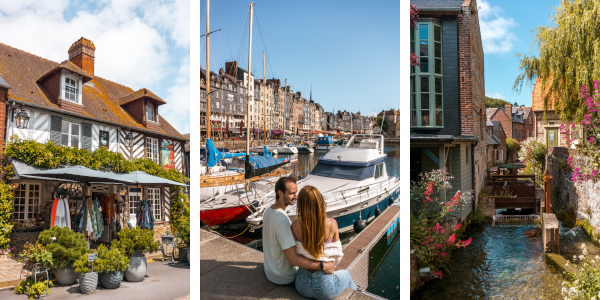
Discover the beauty and charm of Normandy as we take you on a road trip along its breathtaking coast. From the iconic Le Mont-Saint-Michel to the picturesque villages of Beuvron-en-Auge and Veules-les-Roses, this journey promises to be a feast for the senses. Explore the unique city of Le Havre, stroll along the picturesque harbor of Honfleur and marvel at the stunning cliffs of Étretat. Get ready to immerse yourself in the beautiful landscapes of this region. In this blog post, we’re going to take you with us on an unforgettable 3-day road trip along the Coast of Normandy. So, grab your keys and let’s hit the road for an unforgettable adventure!
Day 1
Le Mont-Saint-Michel
We started our road trip in Le Mont-Saint-Michel, where we arrived in the late afternoon. Le Mont-Saint-Michel is a tidal island just off the coast. It is mostly known for its impressive abbey that sits at the very top. During extremely high tides, the island is completely surrounded by the sea.
We spent our late afternoon and evening exploring the village and the bay. Since the tide was very low, we were almost able to walk all the way around the island, offering some great perspectives of Le Mont-Saint-Michel. Tides can change quickly so always be careful when walking around the island during low tide.
Check out our blog post in which we share everything you need to know about visiting Le Mont-Saint-Michel.

Le Mont-Saint-Michel during low tide
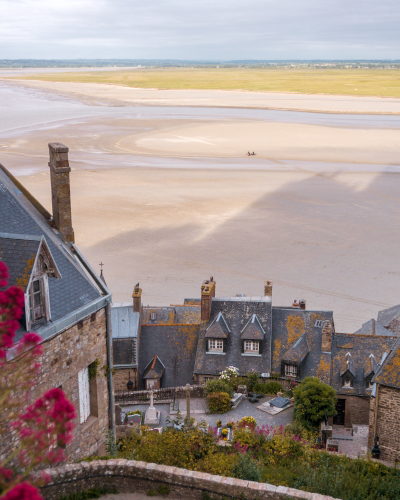
View of the bay from Le Mont-Saint-Michel
Day 2
Le Mont-Saint-Michel
We stayed the night near Le Mont-Saint-Michel and, after a short night of sleep, we got up very early to catch the sunrise. Unfortunately, this didn’t turn out well as it was raining and very foggy making it almost impossible to see the island. After spending some time in the rain trying to make the most of it, we drove to our next destination.
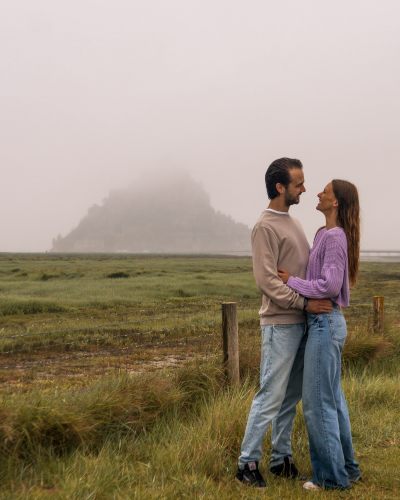
Le Mont-Saint-Michel on a rainy and foggy morning
Beuvron-en-Auge
From Le Mont-Saint-Michel, Beuvron-en-Auge is a 1,5-hour drive away. The tiny village of Beuvron-en-Auge is one of the 172 villages on the list of Les Plus Beaux Villages de France, which is an ever-growing list containing the most beautiful villages of France. We can say from experience that these villages are worth visiting and every time we’re in France, we always check which Plus Beaux Villages are near us.
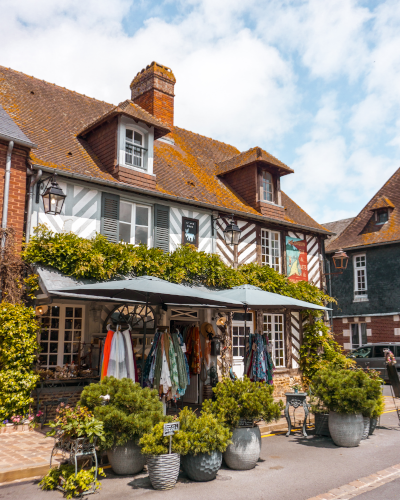
Beuvron-en-Auge
Place Michel Vermughen is located in the heart of the village and is the main attraction. This square is surrounded by picturesque half-timbered houses from which most date back to the 17th and 18th century. As it was lunch time when we got to Beuvron-en-Auge we decided to sit down at Antoine et Lucil, one of the restaurants with outdoor seating areas at Place Michel Vermughen. We enjoyed a delicious lunch.

Lunch in Beuvron-en-Auge
Fun fact: Michel Vermughen was a former mayor of Beuvron-en-Auge and played a huge role in the restoration of the historic village.
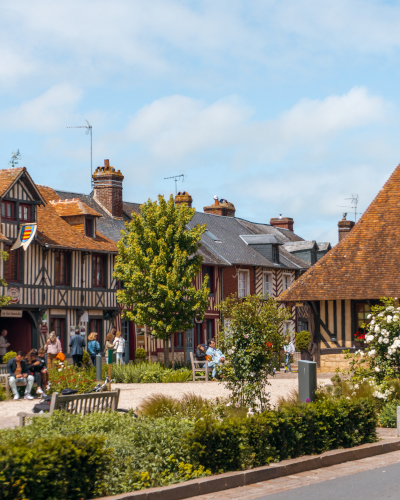
Place Michel Vermughen in Beuvron-en-Auge
Beuvron-en-Auge is located in the Calvados department, which is famous for its many apple orchards. In the shops in the village, you can find all kinds of local culinary delights based on apples, such as ciders, apple pies and the famous Calvados brandy.
This village is home to less than 200 inhabitants, which means that it’s very tiny. You only need a few hours to explore every inch of the village. We’d recommend taking in the beauty of Place Vermughen by having lunch or a drink at one of the outdoor seating areas when the weather allows for it. Take a peek into the shops and maybe bring home some local delights such as cider.

Local shop in Beuvron-en-Auge
We parked our car at the parking lot next to the Tourist Office. When we visited Beuvron-en-Auge on the Friday after Ascension Day (which is a popular long weekend for the French to explore their own country).
Le Havre
After a few hours in Beuvron-en-Auge, we continued our journey by driving one hour to Le Havre. For the next two days, Le Havre would be our base from where we’d explore more places. After checking in at our hotel, we spent the late afternoon and evening exploring the unique city of Le Havre. During World War II, Le Havre was heavily bombed and the city needed to be rebuilt. The French architect Auguste Perret played a major role in rebuilding the city by using reinforced concrete. Because of the exceptional architectural and urban ensemble mostly due to Perret’s work, Le Havre was designated as a UNESCO World Heritage Site in 2005. When wandering through the city, you can recognize Perret’s buildings everywhere. It feels like you’re wandering through an open-air museum!

Architecture of Perret in Le Havre
After admiring the unique architectural ensemble of Perret, we headed to the beach. There’s a nice stretch of pebble beach with a promenade at the west end of the city. It’s the perfect place for a leisurely beach walk anytime of the year. We decided to have dinner at one of the restaurants along the beach promenade. We love having dinner at the beach, especially when the beach is facing west and we can watch the sun set into the ocean.
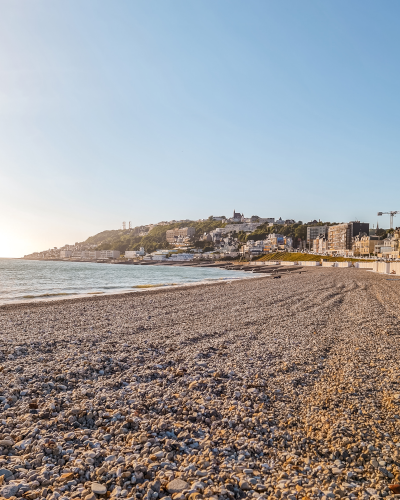
The beach in Le Havre
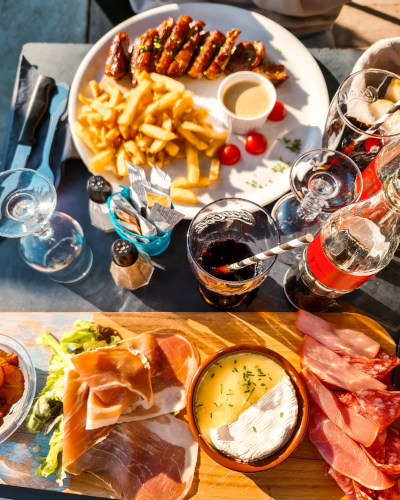
Dinner at the beach in Le Havre
Have a look at our Le Havre blog post for more in-depth information about the city and to find out about the best things to do and see there!
Day 3
Honfleur
After a good night of sleep we headed to the town of Honfleur. From Le Havre, Honfleur is a 30-minute drive crossing the famous Pont de Normandie, also known as Normandy Bridge. Pont de Normandie is a cable-stayed bridge that spans the Seine river and is over 2 km long. When the bridge opened in 1995, it was the longest cable-stayed bridge in the world. In 1999, the record was lost to the Tatara Bridge in Japan. It’s a very impressive bridge to cross, but one could argue that it’s just a longer version of the most beautiful bridge in the world: the Erasmus Bridge in Rotterdam. 😄 It’s a toll bridge, so be aware you have to pay a few euros when crossing it, each way. According to the website of Pont de Normandie, it’s €5,80 for cars each way in 2023.

Pont de Normandie
After crossing the Pont de Normandie, you’ll soon enter the town of Honfleur. Honfleur is mostly famous for its historic port, which is often painted by French impressionist painters, such as Monet and Boudin. Walking along the harbor feels like you’re stepping back in time. We can highly recommend having a snack or drinks at one of the many restaurants with outdoor seating areas that surround the harbor. We had a delicious French breakfast at Perroquet Vert, while soaking up the charming harbor view in the Spring morning sun. When the weather is nice, you might have to be on the lookout for a bit to catch a table, but it’s absolutely worth it!
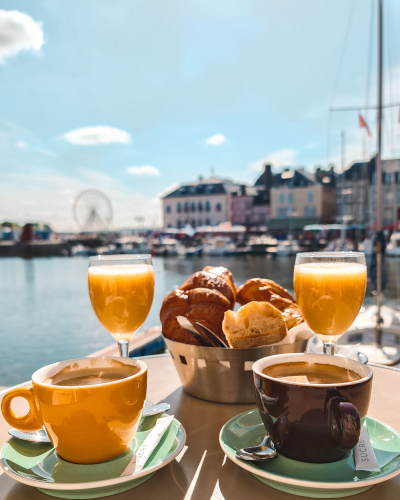
Breakfast at the harbor of Honfleur
The harbor of Honfleur has a long and rich history dating back to the Middle Ages. It was originally a major center for trade and commerce, with ships sailing to and from the harbor carrying goods such as salt, wine, and wood. Over the centuries, the harbor has played a significant role in the history of Honfleur and the surrounding region. In the 16th and 17th centuries, Honfleur became a hub for French explorers who used the harbor as a departure point for their expeditions to the New World. Today, the harbor of Honfleur is a popular tourist destination.

The historic harbor of Honfleur
After having breakfast, we wandered around the town for a bit. It was a crowded Saturday morning and there was a farmer’s market on Rue de la ville and Quai Saint-Etienne. The town is home to many picturesque half-timbered and stone houses. We only spent a few hours in Honfleur, but if you’re staying there longer you can’t miss paying a visit to the Éligse Sainte-Catherine (the largest wooden church in France) and Musée Eugène Boudin (a museum dedicated to the works of Boudin). Fun fact: Boudin was born in Honfleur.
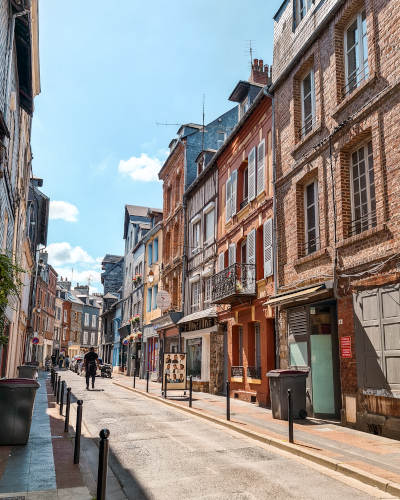
The charming houses in Honfleur
We parked our car in a free parking area near Rue Guillaume de Beaulieu. Space here is limited, so you might not always find a spot. From the free parking area, it’s less than a 10-minute walk to the harbor. Alternatively, there are plenty of paid parking areas available near Honfleur’s harbor and town’s center. Just follow the P-signs when arriving in Honfleur.
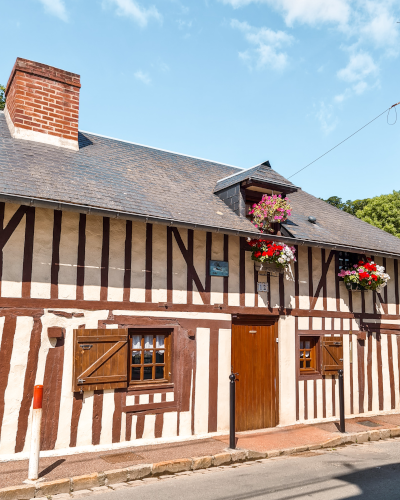
A picturesque half-timbered house in Honfleur
Veules-les-Roses
From Honfleur, we drove to Veules-les-Roses in less than 1,5 hours. Veules-les-Roses is another village that’s on the list of Les Plus Beaux Villages de France. Veules-les-Roses is located right along the Alabaster Coast, which is famous for its white cliffs.
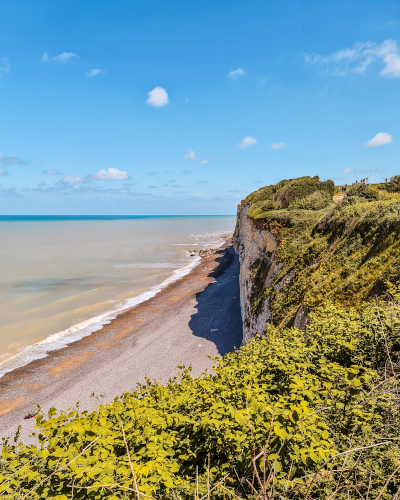
The cliffs in Veules-les-Roses
We started our walk through the village at the beach. Veules-les-Roses has a small stretch of pebble beach with views of the amazing white cliffs. During low tide, a large patch of fine sand is added to the beach. There’s also a small beach promenade. From the beach, we walked along Rue Victor Hugo into the village.
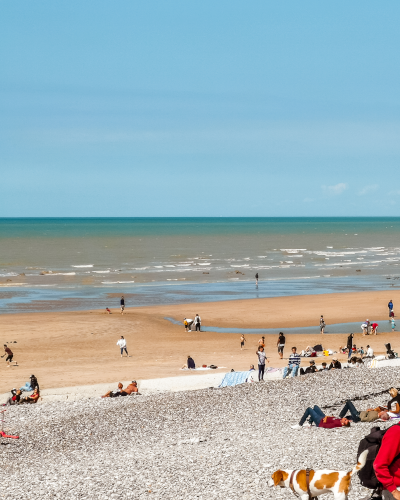
The beach of Veules-les-Roses during low tide
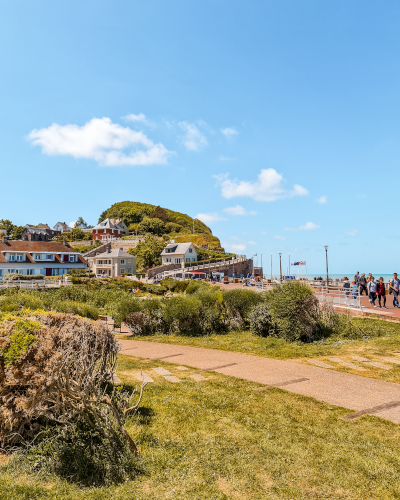
The small beach promenade in Veules-les-Roses
As it was lunchtime, we looked for food in the village, which wasn’t as easy as we thought. It was a crowded Saturday afternoon during the Ascension weekend and it looked like a lot of French tourists were exploring the Coast of Normandy that weekend, just like we were. The tiny village is home to a small number of restaurants, which were all full or closed earlier because of the overwhelming number of customers. After finally having found the last few salads (and seats) left in Comme à la maison, we continued exploring the village.
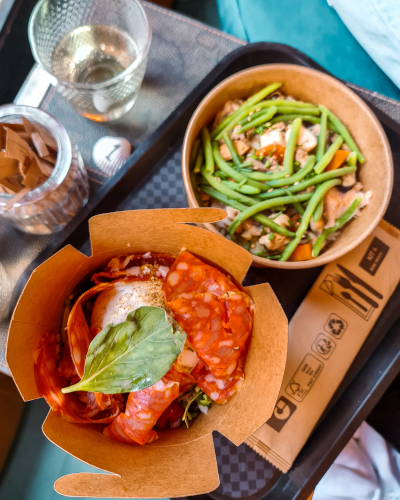
Lunch at Comme à la maison in Veules-les-Roses
Veules-les-Roses knows a rich history and was already a settlement in the 4th century. Throughout its history, Veules-les-Roses has been a fishing village, and its beach and harbor have been used for fishing and trade for centuries. In the 19th century, Veules-les-Roses became a popular destination for tourists, who were drawn to its stunning beach and charming architecture. The village became a hub for artists and writers, such as Victor Hugo. Many of them were inspired by the beauty of the surrounding countryside and the picturesque streets of the village. Nowadays, it’s still a popular tourist destination. Despite the fact that Veules-les-Roses has been a popular tourist destination for over a century, the village has retained its charm.
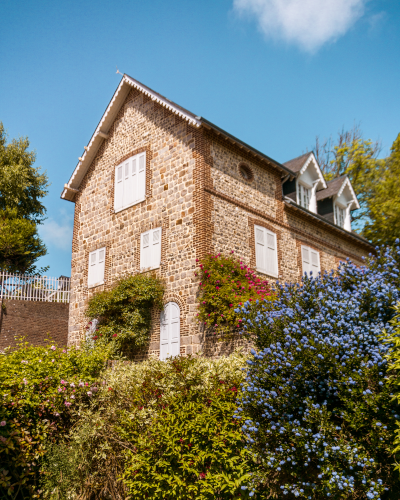
A charming house in Veules-les-Roses
The village is built along the smallest river in France, the Veules. The river is a little over a kilometer long. You can walk all the way along the river from the source until the sea, which we did in the opposite direction: from the sea until the source. Don’t forget to stop at one of the many historic water mills.
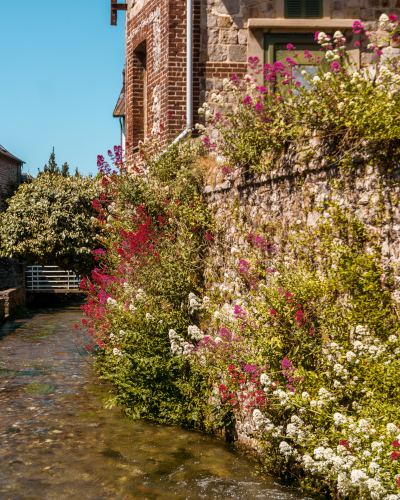
The Veules river in Veules-les-Roses
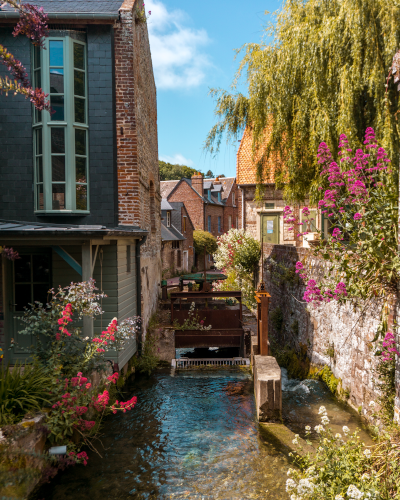
A historic water mill in the Veules river
The source of the Veules river is basically a small pond with water that bubbles up. Near the source, you can find large ponds in which locals grow watercress. The watercress from the river, together with the oysters from the sea are local delicacies of Veules-les-Roses.
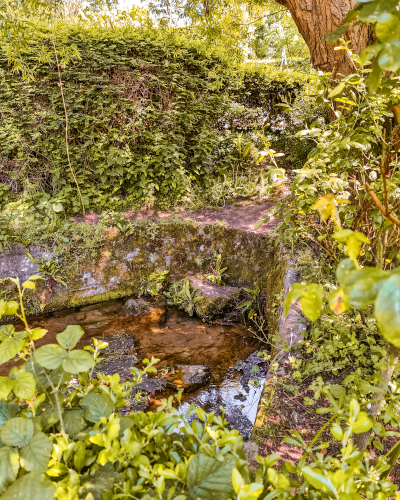
The source of the Veules river
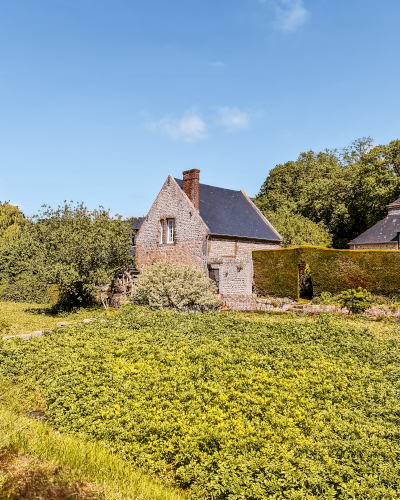
All the greenery in front of the house is watercress growing in a pond
From the source of the Veules, we walked all the way back to the beach and to our car. We parked our car at Parking du Canon, on top of a cliff next to the beach of Veules-les-Roses. You quickly learn why it’s called Parking du Canon, as there’s a huge cannon from World War II on top of the cliff. In June 1940, the Battle of Veules took place here.
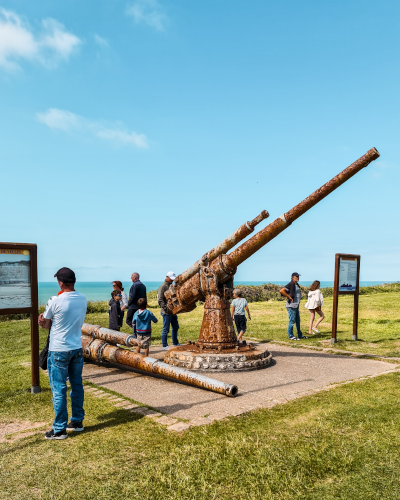
The cannon from World War II on top of the cliff near Parking du Canon
When standing on top of the cliff, there’s a path to your left that leads you down to the beach of Veules-les-Roses.
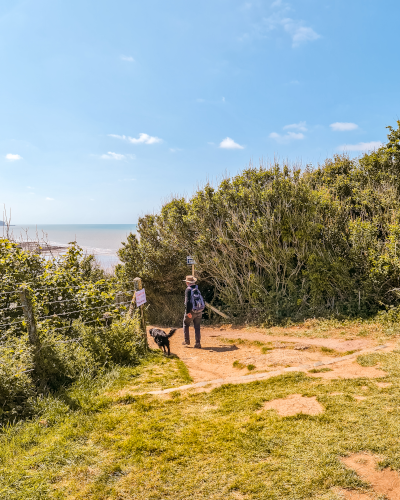
The path that goes down to the beach of Veules-les-Roses
Alternatively, you can park your car near the source of the Veules river and walk from the source through the village all the way up to the beach.
Étretat
Our next and last destination for the day was Étretat. From Veules-les-Roses, Étretat is around a 1-hour drive. Étretat is one of the most famous towns along the Coast of Normandy, mostly known for the breathtaking white cliffs. When in Étretat, we can highly recommend hiking the cliffs and admiring the beautiful nature and views from up there.
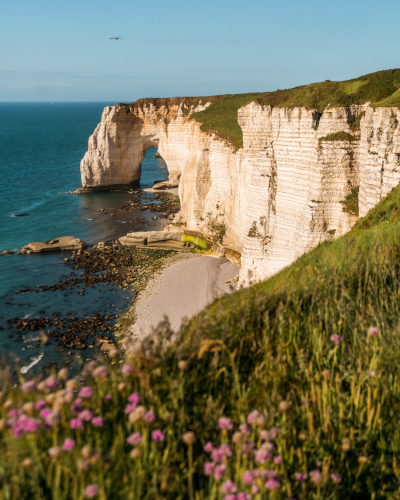
Views during the hike along the cliffs near Étretat
If you can, we also highly recommend staying for the most beautiful time of the day: sunset. As the beach in Étretat is facing west, you can watch the sun set into the sea. The sunset, together with the beautiful cliffs, is just a magnificent combination.
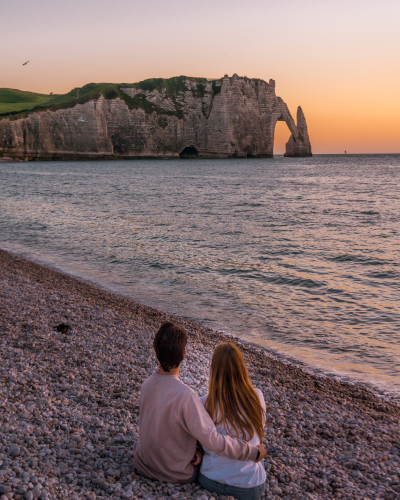
Sunset on the beach in Étretat
In this blog post, we’re sharing everything you need to know about visiting Étretat, including the exact directions of a round-trip hike along the cliffs that you can’t miss doing.
After spending the late afternoon and evening in Étretat, we headed back to our hotel in Le Havre. The next morning we drove home.
Where to stay on the Coast of Normandy
For the first night of our road trip, we stayed near Le Mont-Saint-Michel. Since Le Mont-Saint-Michel is quite a few hours south of the other places we visited along the COast of Normandy, we would highly recommend staying the night in Le Mont-Saint-Michel. Driving to Le Mont-Saint-Michel from Le Havre is simply a bit too far. The advantage of staying in or near Le Mont-Saint-Michel is also that you can enjoy the island in the evening and morning when there are hardly any tourists around.
We would have preferred to stay near the car park in Le Mont-Saint-Michel, but since all hotels there were fully booked we opted for a hotel in the nearby village of Beauvoir. We stayed at Hotel Restaurant Café Le Beauvoir that offers simple and clean rooms for a reasonable price and free parking next to the hotel. It’s a 50-minute walk from the hotel to the tidal island, which is quite long but it’s a pleasant walk as you’re surrounded by nature.
Click here to book a room in Hotel Restaurant Café Le Beauvoir
Click here for more accommodation options in and near Le Mont-Saint-Michel
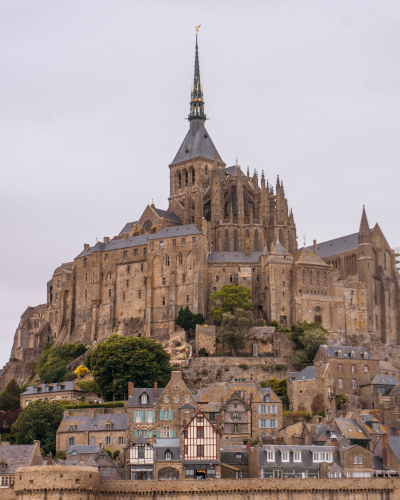
Le Mont-Saint-Michel
For the next two nights of our road trip, we chose Le Havre as our base. This was a great choice because accommodation prices in Le Havre are very reasonable and it’s centrally located between the other places along the coast we’ve visited. Both Étretat and Honfleur are only a 30-minute drive away. Since Le Havre is a city, there are plenty of options for dinner during the evening. If you happen to be in Le Havre during the day, you also won’t be bored as there is a proper shopping center, plenty of museums and other sightseeing spots to fill the day.
We stayed in Ibis Le Havre Centre, which is closely located to the city center. One of the main reasons we chose this hotel was because of the on-site covered parking garage. The rooms are basic, but clean and provided with everything we need. We always opt for Ibis hotels when traveling by car in Europe. If you’re looking for a comfortable but reasonably priced hotel, we can absolutely recommend Ibis Le Havre Centre!
Click here to book a room in Ibis Le Havre Centre
Click here for more accommodation options in Le Havre
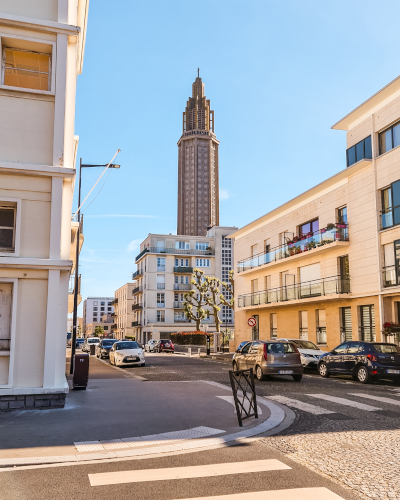
Le Havre
Staying in Honfleur instead of Le Havre is also an option. Honfleur is a lively town with plenty of restaurants and boutique shops. The downside of staying in Honfleur is that the hotels are more expensive compared to Le Havre. You also have to pay toll every time you cross the Pont de Normandie, so you want to be aware of that when creating your itinerary.
Click here for accommodation in Honfleur
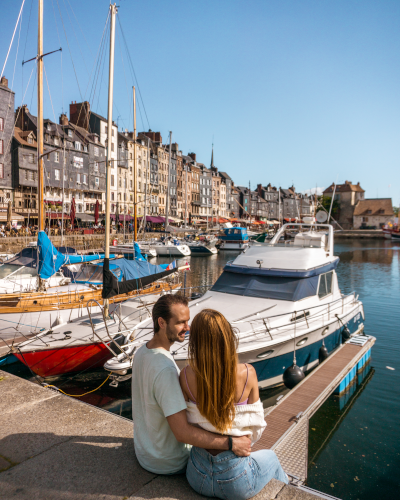
Honfleur
This road trip along the Coast of Normandy is one of our favorite short road trips we’ve done. In just a few days, we were able to visit some of the most beautiful places along the coast. We hope we’ve inspired you to visit this beautiful area of France. Is the Coast of Normandy on your travel bucket list? Let us know in the comments below!
Be sure to check out:
- our online prints store KIPAVISTA.com
- our daily life updates on Instagram
- our YouTube Channel
- our TikTok
More France
3-Day Road Trip in the Seine Valley
The Most Instagrammable Places in Paris
The Prettiest Places to Visit in Provence

